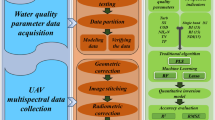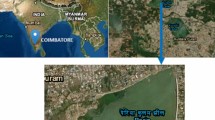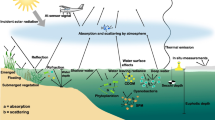Abstract
Water is not only an indispensable part of the natural environment but also an important component and basic guarantee of the urban ecological environment. Total Suspended Matter (TSM) is an important parameter to measure urban water quality. Therefore, it is essential to carry out real-time and efficient monitoring of the total suspended matter of urban water bodies to ensure water quality safety of urban water bodies. In this paper, the inversion model of TSM concentration of urban water is constructed using Unmanned Aerial Vehicle (UAV) multi-spectral images and measured TSM concentration data. The results show that: (1) The NIR band of the UAV image is highly sensitive to TSM concentration. (2) When the sample size is small, it is found that the TSM regression model is more stable and explanatory than the machine learning model. (3) The overall water quality of urban water bodies is poor, especially in areas with intense human activities such as shipping and construction. The TSM concentration in the river reaches is high, and the TSM concentration in the wider river reaches is higher than that in the narrow river channels and Landscape Lakes, and the TSM concentration remains stable in a certain length of river reaches. It can lay a foundation for further realizing real-time and efficient water quality parameter inversion in the future, and also provide an important scientific reference value for other water quality parameter inversion research, and provide theoretical basis and technical support for the scientific management of water ecological environment in urban water bodies.










Similar content being viewed by others
Availability of Data and Materials
The data generated and/or analyzed during the current study are available from the corresponding author on reasonable request.
References
Alizadeh MJ, Jafari NE, Kalarestaghi N, Chau KW (2017) Toward multi-day-ahead forecasting of suspended sediment concentration using ensemble models. Environ Sci Pollut Res 24:28017–28025
Amin I, Fikrat F, Mammado E, Babayev M (2020) Soil organic carbon prediction by Vis-NIR spectroscopy: Case study the Kur-Aras Plain, Azerbaijan. Commun Soil Sci Plant Anal 51(6):726–734
Balasubramanian SV, Pahlevan N, Smith B, Binding C, Schalles J, Loisel H, Gurlin D, Greb S, Alikas K, Randla M et al (2020) Robust algorithm for estimating total suspended solids (TSS) in inland and nearshore coastal waters. Remote Sens Environ 246:111768
Bean TP, Greenwood N, Beckett R, Biermann L, Bignell JP, Brant JL, Copp GH, Declin MJ, Dye S, Feist SW et al (2017) A review of the tools used for marine monitoring in the UK: combining historic and contemporary methods with modeling and socioeconomics to fulfill legislative needs and scientific ambitions. Front Mar Sci 4:263
Belgiu M, Drăguţ L (2016) Random forest in remote sensing: A review of applications and future directions. ISPRS J Photogramm Remote Sens 114:24–31
Cao Z, Ma R, Duan H, Pahlevan N, Melack J, Shen M, Xue K (2020) A machine learning approach to estimate chlorophyll-a from Landsat-8 measurements in inland lakes. Remote Sens Environ 248:111974
Carpenter DJ, Carpenter SM (1983) Modeling inland water quality using Landsat data. Remote Sens Environ 13(4):345–352
Chen T, Guestrin C (2016) Xgboost: A scalable tree boosting system. In Proceedings of the 22nd ACM SIGKDD International Conference on Knowledge Discovery and Data Mining 8:785–794
Cheng KH, Jiao JJ, Luo X, Yu S (2022) Effective coastal Escherichia coli monitoring by unmanned aerial vehicles (UAV) thermal infrared images. Water Res 118900
Chicco D, Warrens MJ, Jurman G (2021) The coefficient of determination R-squared is more informative than SMAPE, MAE, MAPE, MSE and RMSE in regression analysis evaluation. PeerJ Comput Sci 7:e623
Fulazzaky MA (2009) Water quality evaluation system to assess the Brantas river water. Water Resour Manag 23:3019–3033
Gai Y, Yu D, Zhou Y, Yang L, Chen C, Chen J (2020) An improved model for chlorophyll-a concentration retrieval in coastal waters based on UAV-Borne hyperspectral imagery: A case study in Qingdao. China Water 12(10):2769
Geladi P, Kowalski BR (1986) Partial least-squares regression: a tutorial. Anal Chim Acta 185:1–17
Giardino C, Bresciani M, Braga F, Cazzaniga I, De Keukelaere L, Knaeps E, Brando VE (2017) Bio-optical modeling of total suspended solids. Bio-optical modeling and remote sensing of inland waters. Elsevier 129–156
Guo F, Zhang J, Zhu AX, Zhang Z, Zhang H (2021) An assimilation simulation approach for the suspended sediment concentration in inland lakes using a hybrid perturbation generation method. Water Resour Manag 35:2007–2022
Klein GA (1993) A recognition-primed decision (RPD) model of rapid decision making. Decis Mak Act Models Methods 5(4):138–147
Liu X, Zhang Z, Jiang T, Li X, Li Y (2021) Evaluation of the effectiveness of multiple machine learning methods in remote sensing quantitative retrieval of suspended matter concentrations: A case study of Nansi Lake in North China. J Spectrosc 2021:5957376
Liu YJ, Xia K, Feng HL, Fang YM (2019) Inversion of water quality elements in small and micro-size water region using multispectra image by UAV. Acta Sci Circum 39(04):1241–1249
Lu H, Ma X (2020) Hybrid decision tree-based machine learning models for short-term water quality prediction. Chemosphere 249:126169
McKenzie J (2011) Mean absolute percentage error and bias in economic forecasting. Econ Lett 113(3):259–262
Mishra S, Mishra DR, Lee ZP (2013) Bio-optical inversion in highly turbid and cyanobacteria-dominated waters. IEEE Trans Geosci Remote Sens 52(1):375–388
National Standards of the People's Republic of China (1989) Water quality-Determination of suspended substance-Gravimetric method (GB11901–89). Beijing
Novo E, Godoy M (1989) Eutrophication assessment through remote sensing techniques. 12th Canadian Symposium on Remote Sensing Geoscience and Remote Sensing Symposium, IEEE 5:2825–2828
Rigatti SJ (2017) Random forest. J Insur Med 47(1):31–39
Romero-Trigueros C, Nortes PA, Alarcón JJ, Hunink JE, Parra M, Contreras S, Droogers P, Nicolás E (2017) Effects of saline reclaimed waters and deficit irrigation on Citrus physiology assessed by UAV remote sensing. Agric Water Manag 183:60–69
Sun Z, Li J, Tian L, Cehn B, Hu X (2021) Spatial variation and risk assessment of arsenic and heavy metals in surface water and suspended particulate matter in tail reaches of the Yellow River, China. Chin Geogra Sci 31:181–196
Teixeira LC, Mariani PP, Pedrollo OC, dos Reis CNM, Sari V (2020) Artificial neural network and fuzzy inference system models for forecasting suspended sediment and turbidity in basins at different scales. Water Resour Manag 34(11):3709–3723
Wang S, Gao Y, Li Q, Gao J, Zhai S, Zhou Y, Cheng Y (2019) Long-term and inter-monthly dynamics of aquatic vegetation and its relation with environmental factors in Taihu Lake, China. Sci Total Environ 651:367–380
Wang Z, Kawamura K, Sakuno Y, Fan X, Gong Z, Lim J (2017) Retrieval of chlorophyll-a and total suspended solids using iterative stepwise elimination partial least squares (ISE-PLS) regression based on field hyperspectral measurements in irrigation ponds in Higashihiroshima, Japan. Remote Sens 9(3):264
Xia J, Zhang YY, Zhan C, Ye AZ (2011) Water quality management in China: the case of the Huai River Basin. Int J Water Resour Dev 27(1):167–180
Xiao Y, Guo Y, Yin G, Zhang X, Shi Y, Hao F, Fu Y (2022) UAV multispectral image-based urban river water quality monitoring using stacked ensemble machine learning algorithms—A case study of the Zhanghe River, China. Remote Sens 14(14):3272
Ye X, Li Y, Tong L, He L (2017) Remote sensing retrieval of suspended solids in Longquan Lake based on GA-SVM model. 2017 IEEE International Geoscience and Remote Sensing Symposium (IGARSS). IEEE 5501–5504
Yuan J, Wang X, Yan CX, Wang SR, Ju XP, Li Y (2019) Soil moisture retrieval model for remote sensing using reflected hyperspectral information. Remote Sens 11(3):366
Zhu SD, Zhang F, Zhang ZY, Kung HT, Yushanjiang A (2019) Hydrogen and oxygen isotope composition and water quality evaluation for different water bodies in the Ebinur Lake watershed, Northwestern China. Water 11:2067
Zhu W, Yu Q (2012) Inversion of chromophoric dissolved organic matter from EO-1 Hyperion imagery for turbid estuarine and coastal waters. IEEE Trans Geosci Remote Sens 51(6):3286–3298
Funding
This research was supported by grants awarded by Suzhou University of science and technology, the Youth Science Foundation Project of China (41801148).
Author information
Authors and Affiliations
Contributions
All authors contributed to the research conception and design. Material preparation, data collection and analysis were performed by Lei Zhang, Hongchen Yi, Yiping Gu, and Weihao Sun. The first draft of the manuscript was written by Yi Tang and Yang Pan, and all authors commented on previous versions of the manuscript. All authors read and approved the final manuscript.
Corresponding authors
Ethics declarations
Ethics Approval
All authors kept the “Ethical Responsibilities of Authors”.
Consent to Participate
All authors gave explicit consent to participate in this study.
Consent for Publication
All authors gave explicit consent to publish this manuscript.
Competing Interests
The authors have no relevant financial or non-financial interests to disclose.
Additional information
Publisher's Note
Springer Nature remains neutral with regard to jurisdictional claims in published maps and institutional affiliations.
Rights and permissions
Springer Nature or its licensor (e.g. a society or other partner) holds exclusive rights to this article under a publishing agreement with the author(s) or other rightsholder(s); author self-archiving of the accepted manuscript version of this article is solely governed by the terms of such publishing agreement and applicable law.
About this article
Cite this article
Tang, Y., Pan, Y., Zhang, L. et al. Efficient Monitoring of Total Suspended Matter in Urban Water Based on UAV Multi-spectral Images. Water Resour Manage 37, 2143–2160 (2023). https://doi.org/10.1007/s11269-023-03484-2
Received:
Accepted:
Published:
Issue Date:
DOI: https://doi.org/10.1007/s11269-023-03484-2




